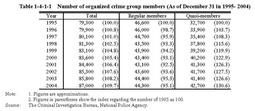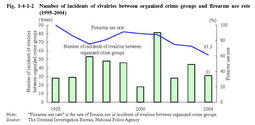| Previous Next Index Image Index Year Selection | |
|
|
1 Trends in organized crime groups Table1-4-1-1 shows the number of organized crime group members,etc.(regular members and quasi-members of organized crime groups;hereinafter the same in this Section),as of December31of each year since1995.
Table1-4-1-1 Number of organized crime group members(As of December31in1995-2004) As of December31,2004,24organized crime groups were designated as designated organized crime groups under the Law for Prevention of Wrongness by Organized Crime Group Members(Law No.77of1991;hereinafter referred to as"Anti-Organized Crime Group Law"in this section).Regular members of the three major groups,the Fifth Yamaguchi-Gumi,the Inagawa-Kai,and the Sumiyoshi-Kai,were around32,300(increased around300from the previous year),and accounting for72.9%of the total regular members of organized crime groups(Source:The Criminal Investigation Bureau,National Police Agency).Under the Anti-Organized Crime Group Law,2,717 termination orders and161 recurrence preventive orders were issued in2004,an increase of108and47from2003,respectively(Source:The Criminal Investigation Bureau,National Police Agency). Fig.1-4-1-2 shows the number of incidents of rivalries between organized crime groups and the firearms use rate(cases of firearm use in those rivalries)over the last10years. Fig.1-4-1-2 Number of incidents of rivalries between organized crime groups and firearms use rete(1995-2004) |

